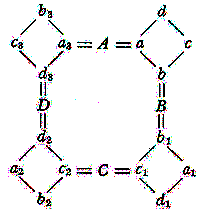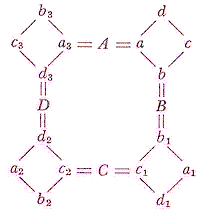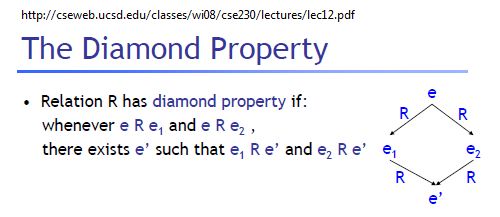Jung’s four-diamond figure from
Aion — a symbol of the self –
For those who prefer the Ed Wood approach —
Jung’s four-diamond figure from
Aion — a symbol of the self –
For those who prefer the Ed Wood approach —
Related art—
Midnight's Icons,
and…
(Wikipedia figure)
"Visually, a tetrad can be depicted as
four diamonds forming an X…."
Mythos
Logos
The six square patterns which, applied as above to the faces of a cube,
form "diamond" and "whirl" patterns, appear also in the logo of a coal-
mining company —
Related material —
Continued from the previous post and from posts
now tagged Dueling Formulas —
The four-diamond formula of Jung and
the four-dot "as" of Claude Lévi-Strauss:


Simplified versions of the diamonds and the dots —
I prefer Jung. For those who prefer Lévi-Strauss —
First edition, Cornell University Press, 1970.
A related tale — "A Meaning, Like."

The above cycle may have influenced the design
of Carl Jung's symbol of the self —

![]()
Related art by
Steven H. Cullinane
See also Levi-Strauss Formula in this journal.
Background: Jung's Aion in this journal discusses this
figure from finite geometry's diamond theorem—
![]()
Fig. A
This resembles a figure that served Jung
as a schema of the Self—

Fig. B
Fig. A, with color variations, serves as the core
of many automatically generated Identicons —
a different sort of self-symbol.
Examples from Sept. 6 at MathOverflow—
![]()
![]()
A user wanting to custom-tailor his self-symbol should consider
the following from the identicon service Gravatar—
1. User Submissions. "… you hereby do and shall grant to Automattic a worldwide, perpetual, irrevocable, royalty-free and fully-paid, transferable (including rights to sublicense) right to perform the Services (e.g., to use, modify, reproduce, distribute, prepare derivative works of, display, perform, and otherwise fully exercise and exploit all intellectual property, publicity, and moral rights with respect to any User Submissions, and to allow others to do so)."
Sounds rather Faustian.

Also known, roughly speaking, as confluence or the Church-Rosser property.
From “NYU Lambda Seminar, Week 2” —
[See also the parent page Seminar in Semantics / Philosophy of Language or:
What Philosophers and Linguists Can Learn From Theoretical Computer Science But Didn’t Know To Ask)]
A computational system is said to be confluent, or to have the Church-Rosser or diamond property, if, whenever there are multiple possible evaluation paths, those that terminate always terminate in the same value. In such a system, the choice of which sub-expressions to evaluate first will only matter if some of them but not others might lead down a non-terminating path.
The untyped lambda calculus is confluent. So long as a computation terminates, it always terminates in the same way. It doesn’t matter which order the sub-expressions are evaluated in.
A computational system is said to be strongly normalizing if every permitted evaluation path is guaranteed to terminate. The untyped lambda calculus is not strongly normalizing: ω ω doesn’t terminate by any evaluation path; and (\x. y) (ω ω) terminates only by some evaluation paths but not by others.
But the untyped lambda calculus enjoys some compensation for this weakness. It’s Turing complete! It can represent any computation we know how to describe. (That’s the cash value of being Turing complete, not the rigorous definition. There is a rigorous definition. However, we don’t know how to rigorously define “any computation we know how to describe.”) And in fact, it’s been proven that you can’t have both. If a computational system is Turing complete, it cannot be strongly normalizing.
There is no connection, apart from the common reference to an elementary geometric shape, between the use of “diamond” in the above Church-Rosser sense and the use of “diamond” in the mathematics of (Cullinane’s) Diamond Theory.
Any attempt to establish such a connection would, it seems, lead quickly into logically dubious territory.
Nevertheless, in the synchronistic spirit of Carl Jung and Arthur Koestler, here are some links to such a territory —
Link One — “Insane Symmetry” (Click image for further details)—
See also the quilt symmetry in this journal on Christmas Day.
Link Two — Divine Symmetry
(George Steiner on the Name in this journal on Dec. 31 last year (“All about Eve“)) —
“The links are direct between the tautology out of the Burning Bush, that ‘I am’ which accords to language the privilege of phrasing the identity of God, on the one hand, and the presumptions of concordance, of equivalence, of translatability, which, though imperfect, empower our dictionaries, our syntax, our rhetoric, on the other. That ‘I am’ has, as it were, at an overwhelming distance, informed all predication. It has spanned the arc between noun and verb, a leap primary to creation and the exercise of creative consciousness in metaphor. Where that fire in the branches has gone out or has been exposed as an optical illusion, the textuality of the world, the agency of the Logos in logic—be it Mosaic, Heraclitean, or Johannine—becomes ‘a dead letter.'”
– George Steiner, Grammars of Creation
(See also, from Hanukkah this year, A Geometric Merkabah and The Dreidel is Cast.)
Link Three – Spanning the Arc —
Part A — Architect Louis Sullivan on “span” (see also Kindergarten at Stonehenge)
Part B — “Span” in category theory at nLab —
Also from nLab — Completing Spans to Diamonds
“It is often interesting whether a given span in some partial ordered set can be completed into a diamond. The property of a collection of spans to consist of spans which are expandable into diamonds is very useful in the theory of rewriting systems and producing normal forms in algebra. There are classical results e.g. Newman’s diamond lemma, Širšov-Bergman’s diamond lemma (Širšov is also sometimes spelled as Shirshov), and Church-Rosser theorem (and the corresponding Church-Rosser confluence property).”
The concepts in this last paragraph may or may not have influenced the diamond theory of Rudolf Kaehr (apparently dating from 2007).
They certainly have nothing to do with the Diamond Theory of Steven H. Cullinane (dating from 1976).
For more on what the above San Francisco art curator is pleased to call “insane symmetry,” see this journal on Christmas Day.
For related philosophical lucubrations (more in the spirit of Kaehr than of Steiner), see the New York Times “The Stone” essay “Span: A Remembrance,” from December 22—
“To understand ourselves well,” [architect Louis] Sullivan writes, “we must arrive first at a simple basis: then build up from it.”
Around 300 BC, Euclid arrived at this: “A point is that which has no part. A line is breadthless length.”
See also the link from Christmas Day to remarks on Euclid and “architectonic” in Mere Geometry.
The Medium is the Message
From the Wikipedia article
on Marshall McLuhan–
(Click images for some background.)
Related material:
a web page on McLuhan's
student Walter J. Ong, S. J.,
Time and Chance, continued…
NY Lottery numbers today–
Midday 401, Evening 717
_________________________________________________
From this journal on 4/01, 2009:
The Cruelest Month

"Langdon sensed she was
toying with him…."
___________________________________________
From this journal on 7/17, 2008:
Jung’s four-diamond figure from
Aion — a symbol of the self –

Jung’s Map of the Soul,
by Murray Stein:
“… Jung thinks of the self as undergoing continual transformation during the course of a lifetime…. At the end of his late work Aion, Jung presents a diagram to illustrate the dynamic movements of the self….”
For related dynamic movements,
see the Diamond 16 Puzzle
and the diamond theorem.
|
CHANGE FEW CAN BELIEVE IN |
Continued from June 18.
Jungian Symbols
of the Self —

Compare and contrast:
Jung's four-diamond figure from
Aion — a symbol of the self —

Jung's Map of the Soul,
by Murray Stein:
John Baez, Week 266
(June 20, 2008):
“The Renaissance thinkers liked to
organize the four elements using
a chain of analogies running
from light to heavy:
fire : air :: air : water :: water : earth
They also organized them
in a diamond, like this:”

This figure of Baez
is related to a saying
attributed to Heraclitus:

For related thoughts by Jung,
see Aion, which contains the
following diagram:

“The formula reproduces exactly the essential features of the symbolic process of transformation. It shows the rotation of the mandala, the antithetical play of complementary (or compensatory) processes, then the apocatastasis, i.e., the restoration of an original state of wholeness, which the alchemists expressed through the symbol of the uroboros, and finally the formula repeats the ancient alchemical tetrameria, which is implicit in the fourfold structure of unity.”
— Carl Gustav Jung
That the words Maximus of Tyre (second century A.D.) attributed to Heraclitus imply a cycle of the elements (analogous to the rotation in Jung’s diagram) is not a new concept. For further details, see “The Rotation of the Elements,” a 1995 webpage by one “John Opsopaus.”
Related material:
Log24 entries of June 9, 2008, and
“Quintessence: A Glass Bead Game,”
by Charles Cameron.
Our Judeo-Christian
Heritage –
Lottery
Hermeneutics
Part I: Judeo
| The Lottery 12/9/06 | Mid-day | Evening |
| New York | 036
See |
331
See 3/31— “square crystal” and “the symbolism could not have been more perfect.” |
| Pennsylvania | 602
See 6/02— Walter Benjamin |
111
See 1/11— “Related material:
|
Part II: Christian
| The Lottery 4/3/07 | Mid-day | Evening |
| New York | 115
See 1/15— |
017
See |
| Pennsylvania | 604
See |
714
See |
Related material:
It is perhaps relevant to
this Holy Week that the
date 6/04 (2006) above
refers to both the Christian
holy day of Pentecost and
to the day of the
facetious baccalaureate
of the Class of 2006 in
the University Chapel
at Princeton.
For further context for the
Log24 remarks of that same
date, see June 1-15, 2006.
Time and Chance
on the 90th Birthday
of Kirk Douglas,
star of
“The Garden of Allah“
| The Lottery 12/9/06 | Mid-day | Evening |
| New York | 036
See |
331
See 3/31— “square crystal” and “the symbolism could not have been more perfect.” |
| Pennsylvania | 602
See 6/02— Walter Benjamin |
111
See 1/11— “Related material: |

From Jung’s Map of the Soul, by Murray Stein:
“… Jung thinks of the self as undergoing continual transformation during the course of a lifetime…. At the end of his late work Aion, Jung presents a diagram to illustrate the dynamic movements of the self….”

“The formula presents a symbol of the self, for the self is not just a stable quantity or constant form, but is also a dynamic process. In the same way, the ancients saw the imago Dei in man not as a mere imprint, as a sort of lifeless, stereotyped impression, but as an active force…. The four transformations represent a process of restoration or rejuvenation taking place, as it were, inside the self….”
“The formula reproduces exactly the essential features of the symbolic process of transformation. It shows the rotation of the mandala, the antithetical play of complementary (or compensatory) processes, then the apocatastasis, i.e., the restoration of an original state of wholeness, which the alchemists expressed through the symbol of the uroboros, and finally the formula repeats the ancient alchemical tetrameria, which is implicit in the fourfold structure of unity.
What the formula can only hint at, however, is the higher plane that is reached through the process of transformation and integration. The ‘sublimation’ or progress or qualitative change consists in an unfolding of totality into four parts four times, which means nothing less than its becoming conscious. When psychic contents are split up into four aspects, it means that they have been subjected to discrimination by the four orienting functions of consciousness. Only the production of these four aspects makes a total description possible. The process depicted by our formula changes the originally unconscious totality into a conscious one.”
— Jung, Collected Works,
Vol. 9, Part 2, Aion: Researches into the Phenomenology of the Self (1951)
Related material:
“Although ‘wholeness’ seems at first sight to be nothing but an abstract idea (like anima and animus), it is nevertheless empirical in so far as it is anticipated by the psyche in the form of spontaneous or autonomous symbols. These are the quaternity or mandala symbols, which occur not only in the dreams of modern people who have never heard of them, but are widely disseminated in the historical recods of many peoples and many epochs. Their significance as symbols of unity and totality is amply confirmed by history as well as by empirical psychology. What at first looks like an abstract idea stands in reality for something that exists and can be experienced, that demonstrates its a priori presence spontaneously. Wholeness is thus an objective factor that confronts the subject independently of him… Unity and totality stand at the highest point on the scale of objective values because their symbols can no longer be distinguished from the imago Dei. Hence all statements about the God-image apply also to the empirical symbols of totality.”
— Jung, Aion, as quoted in
Carl Jung and Thomas Merton
Quartet
An illustration from July 26,
Jung’s birthday and the date
of Alexander Hammid’s death:
of the Self:  Four Quartets: “… history is a pattern |
Alexander |
From today’s
|
“… legend has it, supported by Casals himself, that he was conceived when Brahms began his B-flat Major Quartet, of which Casals owned the original manuscript, and that he was born when Brahms completed its composition.”
Happy Birthday,
Carl Jung
|
Jung in Von Franz's Psyche and Matter, p. 85: "What the formula can only hint at is the higher plane that is reached through the process of transformation…. The change consists in an unfolding of totality into four parts four times, which means nothing less than its becoming conscious."
Jung's Model of the Self:  Four Quartets:
"… history is a pattern Cold Mountain, the film:
Inman: You are all that keeps me from sliding into some dark place. |
Powered by WordPress